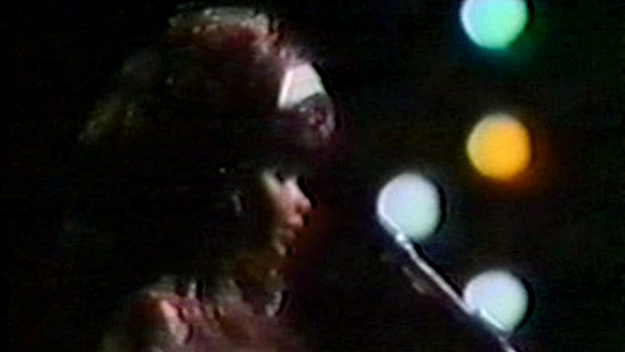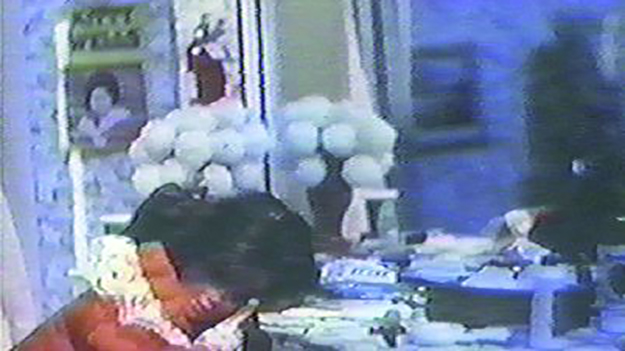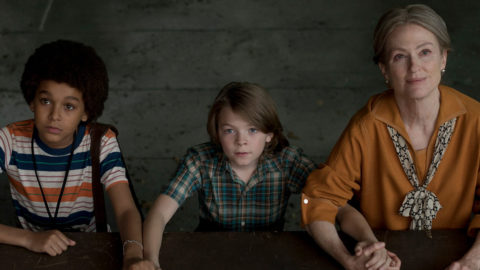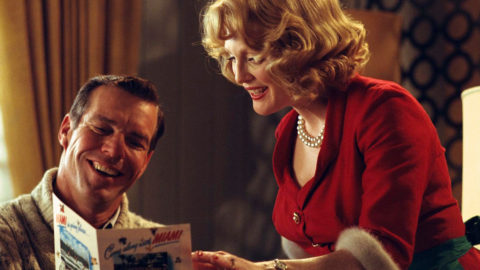Queer & Now & Then: 1988
In this biweekly column, Michael Koresky looks back through a century of cinema for traces of queerness, whether in plain sight or under the surface. Read the introductory essay.

Images from Superstar: The Karen Carpenter Story (Todd Haynes, 1988)
Todd Haynes can queer just about anything. That’s a compliment. It’s a particular ability, peculiar by definition. Of all the directors who rose to prominence during the New Queer Cinema’s ascendance in the late ’80s and early ’90s, Haynes has perhaps made the most persuasive case for one of the ongoing ambiguities, if not debates, about gay filmmaking: namely whether the queerness of artists is necessarily reflected in their work regardless of whether the content, subject matter, or characters onscreen are themselves explicitly queer. Haynes certainly marked himself—forthrightly and politically—as a gay filmmaker with the 1991 release of his triptych Sundance sensation Poison and its subsequent controversy, speciously drummed up by the religious right in the midst of its “culture wars.” His later films about outwardly gay and lesbian characters, such as Velvet Goldmine and Carol, have firmly entrenched Haynes as one of our most sensitive and analytical chroniclers of historical gay life, yet Haynes’s Safe, Far from Heaven, I’m Not There, Mildred Pierce, and Wonderstruck are all, in their own way, examples of an artist also wrestling with the essential queerness of being, embracing an aesthetics of marginalization and redefining the parameters of generic signifiers once presumed to be surface heterosexual.
Haynes’s films—and often his characters—are informed by some kind of unspoken historical trauma. This is a baseline queer notion, as it places people in cycles of repetition and denial, and therefore inherently rejects the forward motion necessitated by heteronormative social and temporal standards. Think of the abused, impossible “flying” child in Poison; think of Julianne Moore’s Carol White in Safe, unlikely to ever receive, accept, or process an answer for all that ails her; or of Moore’s Cathy in Far from Heaven, trapped in a suffocating suburban hell that offers no escape hatch for wives and mothers. Even consider Kate Winslet’s Mildred Pierce, whose endlessly regenerating conflicts with her monstrous daughter and the classist society that bred her leave her with few options other than, finally, to get “stinko.” The beauty of the criminally underappreciated Wonderstruck is that—via its elegant temporal cross-cutting—the film allows its outcast, hearing-impaired children to reach across time and connect with one another, yet their bond is one borne out of marginalization, the self-evident fact that they exist outside of the dominant social narrative.
Remarkably, what would become Haynes’s recurring inquiries into the emotional and physical effects of trauma, and how they essentially queer human social experience, were all on display from very early in his career. His 43-minute Superstar: The Karen Carpenter Story, first screened in 1988, is often called “notorious” or “controversial,” but that’s only because of the culture of gatekeeping and celebrity worship that stigmatized it. A kind of mock biopic of the pop singer, who died in 1983 of complications from anorexia nervosa, Superstar is surely first remembered as that movie that was filmed almost entirely with Barbie dolls, and which faced intense—and successful—efforts to thwart its distribution from multiple corners, including the Mattel toy company, whose plastic figurines were arranged in dramatic, often grotesque fashion; A&M Records, whose Carpenters songbook was employed by Haynes in consistently ironic-tragic fashion; and Richard Carpenter himself, the doll version of which doesn’t come across as particularly sympathetic towards his sister. Yet it’s essential at this point to separate one’s consideration of the film itself from the efforts of the litigious people trying to stop you from seeing it for their own personal reasons. At this point, Superstar is kind of a cinematic open secret, available to stream online, where the rules of music licensing and supposed character defamation don’t necessarily apply. Even the degraded, pixelated quality of the bootleg version found on the Internet functions well for the film’s status as both lost object and half-remembered nightmare. Superstar, by design, is not something you fondly recall; like Safe, it’s a film that uses a literal disease as cover for something less medically diagnosable—a social rot so deeply entrenched that there may be no cure.

Superstar, which Haynes conceived and co-wrote with Cynthia Schneider, is less about depicting a female celebrity’s fall from grace than about investigating the ways in her fall from grace has been mediated—not only through melodramatic genre templates but also by those people who control their images. In this case, it’s A&M Records and Richard Carpenter, who is continually depicted as refusing to treat Karen as an individual rather than as part of a brother-sister duo, responding to her sickness with phrases like, “You are ruining us” and accusing her of trying to destroy “our career.” By representing Karen Carpenter as a doll, the film becomes inescapably about bearing witness to the gradual ravaging of a body and those who took away that body’s agency. Richard’s successful campaign to suppress this film is just one way that her being and image are still controlled so many decades after her death.
Haynes’s two earlier short films are nearly impossible to find: 1978’s The Suicide and 1985’s Assassins: A Film Concerning Rimbaud, which Haynes told Nick Davis in a Film Comment interview is also about how celebrity is mediated: “What it always was to me, is a story of translation: the way Rimbaud is appropriated by artists and writers, who almost covet him as their own.” The comparably accessible Superstar, which he made in his late twenties, stands for most of us as the earliest evidence of Haynes’s preternatural gifts for clarity of intent and narrative, regardless of the form his inquiries take. The film is told with an almost classical cinematic vernacular: zooms and tracking shots, instances of rack focus for emotional emphasis, rear projection. With such a grounding use of basic film grammar, Haynes is then able to muddy the waters, incorporating more outwardly experimental asides, like subliminal cutaways, seemingly unmotivated montages, and graphic layering effects to predict the horrors that await.
The toying with genre that would come to partly define Haynes’s career can be felt in the very opening shots, which employ a horror movie aesthetic in depicting Karen’s mother discovering her dead body: a shaky POV shot as the camera stumbles around an empty house, ominous synth music on the soundtrack portending the worst. But these conventions were also generic markers of the now largely defunct tradition of the TV “movie of the week.” As onscreen text reminds us, this is “A Dramatization,” a word with distinct irony since using Barbie dolls makes that fact perfectly clear. Coming at the beginning, this declaration may be the last real joke of the movie, for Superstar is miraculous for how insistently unfunny it is.
With the immobile faces of the dolls naturally expressionless, Haynes relies on their uncanny effect—and the unironic vocal performances of the actors—to invest them with just enough emotion to carry us through a medium-length narrative. From merely reading about the film, it’s easy to imagine Superstar not working at all, a coherent concept that could have been easily betrayed by shoddy execution. As he would do in so many subsequent films, especially Poison, Safe, and Far from Heaven, Haynes takes materials and even methods that could easily be deployed for cheap satire and perfectly calibrates them so that any potential laughs get caught in the viewer’s throat. As a text card tells us early on, Haynes intends to present us with an “extremely graphic picture of the internal experience of contemporary femininity.” Chuckle at that use of direct, academic address at your own peril.

Haynes examines Karen Carpenter in a variety of ways, but always as a co-opted image of a human being rather than a human being in her own right. This is a pretty fair dramatic interpretation of the wages of fame, and an idea Haynes would expand upon and further complicate in his Bob Dylan film I’m Not There—which might have been a pretty good title for Superstar, come to think of it. As a performer, Karen comes across as little more than an innocent, an effect made all the more acute by surrounding her figure in ominous darkness when onstage. Hearing the real Carpenters recordings of such songs as “We’ve Only Just Begun,” “Close to You,” and the title track, is, of course, essential for achieving Superstar’s mood and effect, her tender, versatile contralto functioning in marked contrast to the increasing degradation of her situation. Her voice is lauded at one point for its “wholesomeness and easy-handed faith,” but Haynes also incorporates still-standing critiques of the Carpenters’ “too clean and sweet” sound, which rang out in pointed contrast to the tumult of the early ’70s, and, according to commentator Michelle Hoyt, “epitomized the return to reactionary values.” That the Carpenters are invited by President Nixon to sing at a White House brunch becomes just another way in which Karen is used by others for purposes beyond her control or intent.
As Karen’s complex, internal struggles with food and her own distorted self-image grow, music becomes increasingly incidental in the film’s dramatic stakes. Haynes underscores, with onscreen text, that anorexia nervosa represents a kind of “fascism of the body,” in which the afflicted person’s attempts to control her own bodily processes are ultimately inverted, so that the affliction ends up controlling the person—expressed effectively in plates of food that look like undifferentiated masses of grey. Haynes implies, then, that Karen’s eating disorder—first implanted in her because of the impossible social expectations put upon women, exacerbated by being in the public eye—is the natural and final evil in a succession of systems attempting to control her: familial, professional, financial, and, at last, physical.
Haynes’s radical form elegantly zigzags between documentary directness; dramatic re-creation; apparent non sequiturs, such as repeated, perhaps mock-Freudian shots of a doll getting spanked; and dissertation-like statement of intent. His film gives the sense of late-’80s postmodern collage, in which everything is at once a play with convention and as deadly serious as the material demands. In this way, it’s a crucial precursor to the mode of address of the New Queer Cinema movement, which was about to coalesce in great part because of the AIDS crisis. Superstar, like Poison and Safe to come, refuse to offer easy answers—or pose safe questions—about disease, knowing all too well that sickness goes deeper, way deeper, than any one human body can represent.
Michael Koresky is a writer, editor, and filmmaker in Brooklyn. He is cofounder and editor of the online film magazine Reverse Shot, a publication of Museum of the Moving Image; a regular contributor to the Criterion Collection and Film Comment, where he writes the biweekly column Queer and Now and Then; and the author of Terence Davies, published by University of Illinois Press, 2014.







